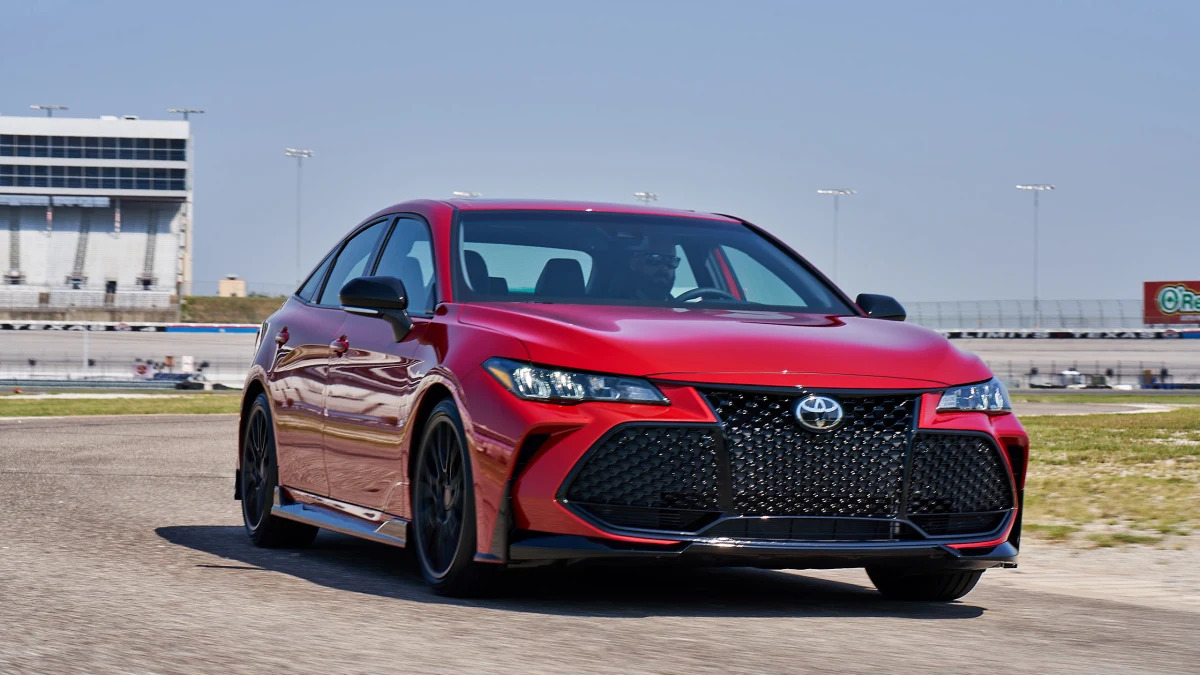-
TrimTRD
-
Engine3.5L V-6
-
Power301 HP / 267 LB-FT
-
Transmission8-Speed Automatic
-
DrivetrainFWD
-
Engine PlacementFront
-
Curb Weight3,638
-
Seating2+3
-
Cargo16 Cu. Ft.
-
MPG22 City / 25 HWY
-
Base Price$43,255
DALLAS, Tex. — How badly does Toyota want to remake its image as a purveyor of reliable but boring vehicles? Very badly indeed, it would appear. We’ve seen the fruits of the company’s effort with the return of the Supra sports car, but we’ve also seen it in unexpected ways, perhaps none more so than the arrival of the 2020 Avalon TRD.
With an average age in the mid-60s, the Avalon has the oldest owner body of any model in the Toyota lineup. Yet Toyota has sent its full-size sedan in for a TRD makeover, and the result is curious but also endearing. Grandpa’s got a brand-new bag.
TRD (Toyota Racing Development) is the brand’s tuner arm, and its ministrations to the Avalon largely mirror those of the only-slightly less-surprising Camry TRD, which debuted alongside its bigger brother. As with the Camry TRD, the chassis has received the bulk of the attention, with the aim of improving the big sedan’s handling. Perhaps owing to its senior status (or status with seniors), the work is not quite as extensive here as it was with the Camry.
But you’ll notice it on the outside, where the Avalon TRD builds off the XSE trim level, adding a larger front splitter below the gloss-black mesh grille, lower body skirts in black with red striping, black window trim and outside mirrors, a rear diffuser, and a larger rear spoiler (although not the Camry TRD’s rear wing). There are TRD-specific 19-inch wheels, also in black, and the brake calipers are painted red. Exterior colors are limited to red, black, silver, and pearl white.



You’ll notice it, too, on the inside, where the TRD’s seats are upholstered in perforated SofTex (Toyota’s manmade-leather material), with microsuede inserts, and feature red accents and “TRD” stitched into the headrests. There’s more red stitching on the dash pad, the door armrests, the steering wheel, and the shift boot. The floor mats are edged in red, and the pedals get metal trim. As in the XSE, textured metal trim is used on place of wood on the dash and door panels, but there’s grained hard plastic on the console that is somewhat disappointing. Functionally, there’s nothing to criticize here, and the 9-inch infotainment screen that sits atop the center stack includes hard buttons to quickly jump between major functions. Unlike the Camry TRD, the Avalon gets a sunroof.
From behind the wheel, you’ll notice the TRD changes most off all on a tight autocross course. We drove a TRD back-to-back with a regular Avalon, and the difference between the two was marked. Wheeling the regular Avalon through the cones felt like piloting a Ford LTD in a 1970s cop show. Crank the wheel in the standard Avalon, and you wait, wait, wait for the car to come screeching around the corner, heeled over on its outside front tire. The Avalon TRD, by contrast, still feels like a big car, but it’s a big car that responds. Turn-in is much more energetic, understeer is under control, and transitions are far tidier. Note that this comparison was against an Avalon Touring, with its adaptive dampers in Sport+ mode. The Avalon TRD, however, does without that technology.



Instead, the Avalon TRD uses non-adaptive dampers with firmer tuning and internal rebound springs. The TRD sits 0.6 inch lower on stiffer springs, and its anti-roll bars are stiffer than those of the standard model. The TRD also adds Toyota’s Active Cornering Assist, which can brake an inside wheel under power in curves to reduce understeer and tighten the car’s line. Additionally, the front brake hardware has been beefed up with larger rotors and two-piston calipers. The Avalon also has more robust underbody braces (three of them) as on the Camry TRD, but it does not get that car’s V-brace behind the rear seatback. Nor does it get the Camry TRD’s stickier summer tires, instead retaining the all-season Michelin Primacy MXV4s used by the Avalon Touring model. The Avalon’s TRD-specific 19” wheels are 4.5 pounds lighter, however.
The TRD is powered by the same naturally aspirated V6 found in other Avalon models, and it is unchanged for TRD duty. Displacing 3.5 liters, it spins out 301 horsepower and 267 lb-ft of torque, distilled to the front wheels through a smooth-shifting and responsive 8-speed automatic with paddle shifters. In a sedan weighing well under 4,000 pounds, that’s enough for robust acceleration, but not so much as to induce annoying torque steer. Even with a mashed accelerator, this Avalon goes where it’s pointed.

What is different with the powertrain here is the TRD-specific cat-back exhaust system. Although it doesn’t alter the output totals, it does contribute to a satisfying, tearing-paper engine sound as the tach needle climbs past 4,000 rpm or so. The downside of the more free-flowing exhaust system is some droning resonance around 60 mph, but it’s really not enough to disrupt the Avalon’s still-placid highway demeanor. Nor is that demeanor totally upended by the firmer suspension. The Avalon TRD feels pleasantly tied down but not terribly harsh — at least that was the impression on the fairly smooth roads where we drove the Avalon in north Texas. Beat-up boulevards in the Northeast or Midwest might reveal something more.
Priced at $43,255 (with destination), the TRD sits near the top of the 2020 Avalon lineup, just $200 below the Touring and $5,000 above the XSE. Toyota says production is limited to fewer than 2,600. That’s not a huge number, but it should be enough to raise a few eyebrows and help raise the profile of this once-sleepy sedan.










Sign in to post
Please sign in to leave a comment.
Continue